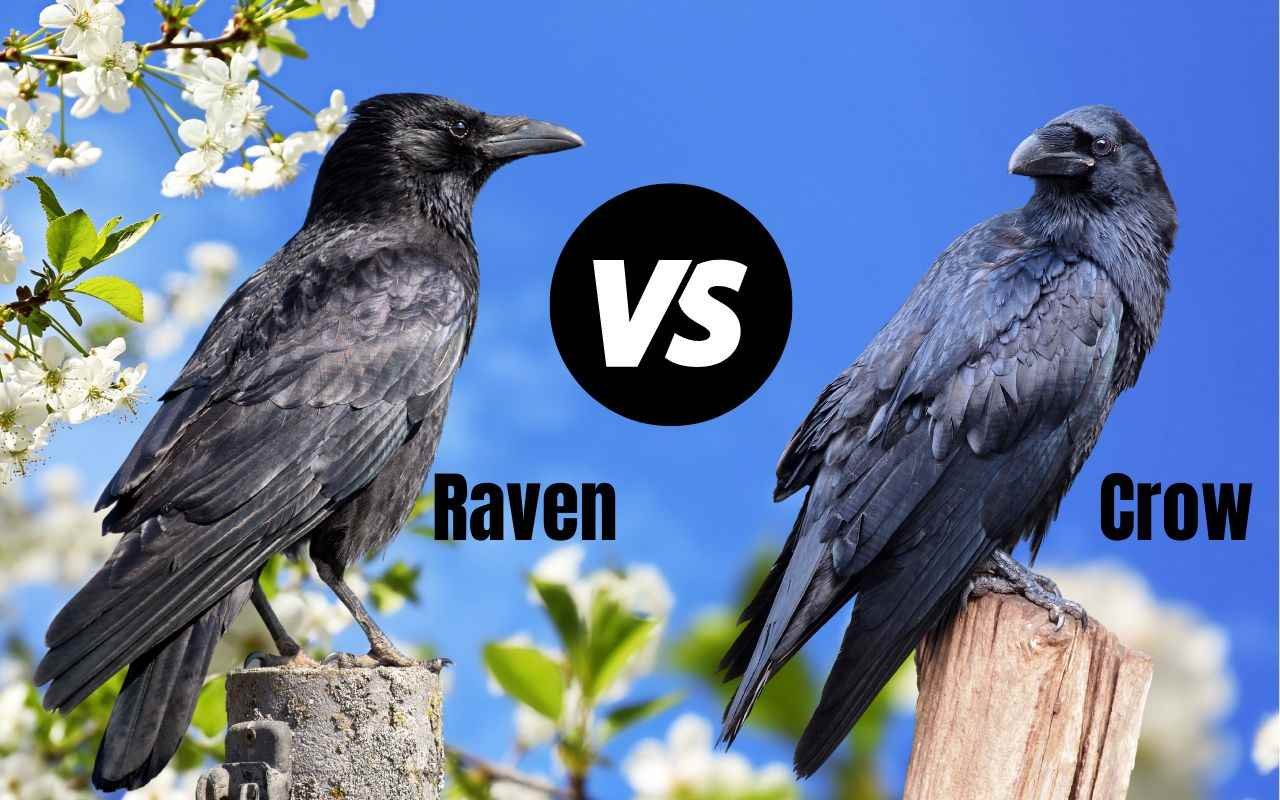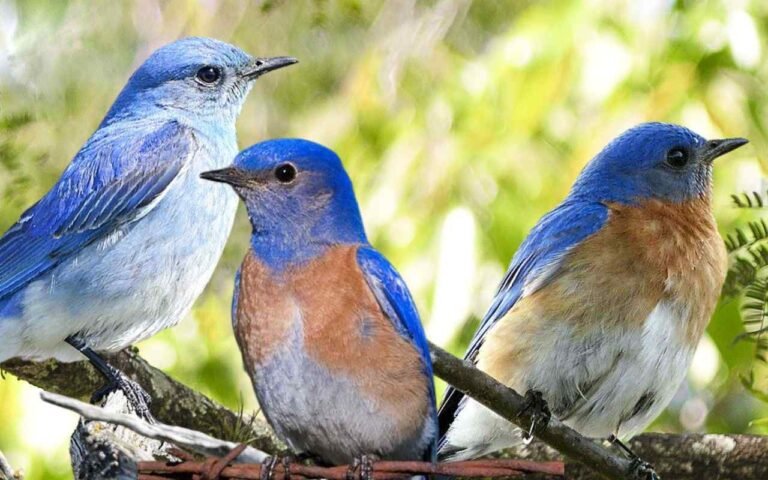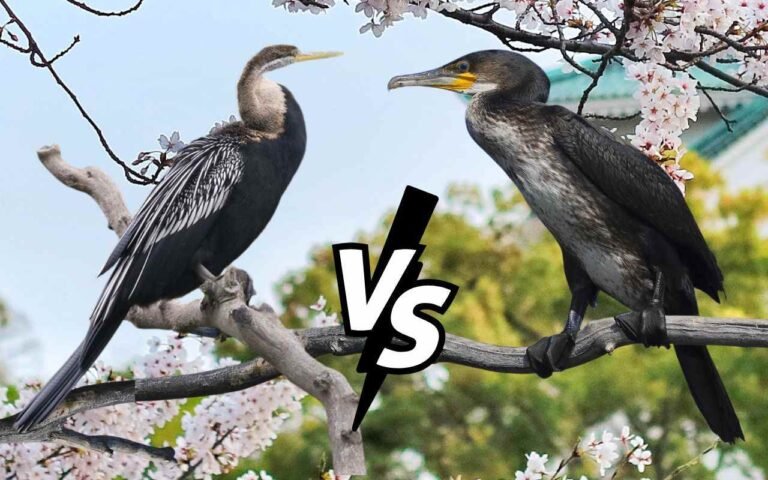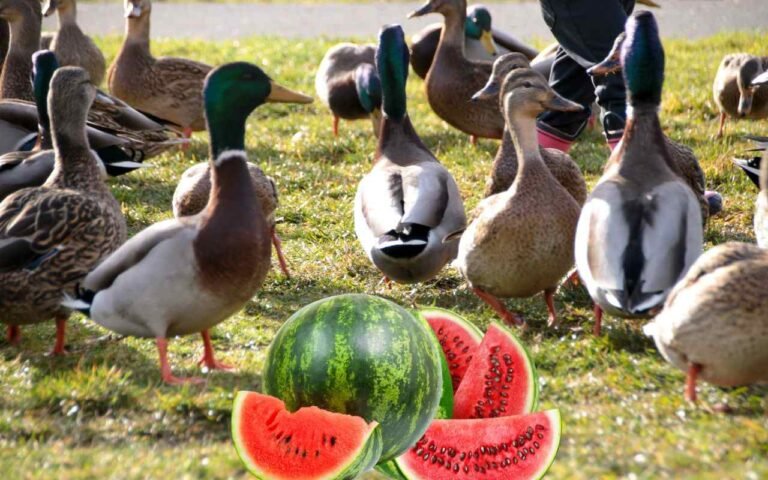Differences Between Crows and Ravens-What Do You Need to Know About the Crow Vs Raven Comparison?
Differences between crows and ravens are important for many parts of our existence. Two of the most prevalent birds in North America are crows and ravens. Although both birds are clever and adaptive, there are some significant distinctions between them.
Identifying these two birds makes it easier to understand their behavior and ecological roles and safeguard them. Crows and ravens control insect populations, seed dispersal, and pollination in various habitats. Their presence in art, mythology, and culture greatly influences our imagination. Valuing and safeguarding these observant and fascinating corvids may help humans, and these remarkable creatures coexist. We shall examine these differences in more detail in this article, along with their consequences for the ecology and behavior of these two species.
Differences between crows and ravens
| Characteristic | Crows | Ravens |
|---|---|---|
| Size and Build | Generally smaller and more slender. | Larger and more robust. |
| Tail | Shorter tail. | Longer tail. |
| Beak | More curved beak. | Straighter beak. |
| Call | Harsh "caw" sound. | Deeper, more melodious call. |
| Habitat | Commonly found in urban areas. | Prefer forests and mountainous regions. |
| Nesting Habits | Nests on trees, bushes, or high buildings. | Builds larger nests in tall trees or cliffs. |
| Interaction with Humans | Feeling at ease in busy locations. | Although more restrained in conduct, it may be seen close to others. |
| Cultural Symbolism | Connected with death and ill luck in various cultures. | Regarded in other cultures as supernatural entities with intelligence. |
| Intelligence and Adaptability | Really sharp and flexible. | Recognized for social skills and problem-solving ability. |
| Migrations | Short-distance migrations may be practiced by certain animals. | They often display year-round occupancy on their lands. |
| Mimicry | Limited capacity for sound emulation. | Can imitate a wide range of sounds, including human speech. |
| Color of Feathers | Typically all-black feathers. | Black-only feathers with a metallic gloss. |
| Vocalization Patterns | Communication is urged by the "caw" vocal and social cues. | More complicated communication noises and vocalizations with a wider variety. |
| Prevalence | Widespread and present in a variety of geographical areas. | Less common, yet found in many places across the globe. |
| Scientific Classification | Family: Corvidae | Family: Corvidae |

Physical Characteristics
There are significant physical distinctions between crows and ravens. Compared to crows, ravens have longer, sharper feathers and a heavier beak. These distinctive characteristics make distinguishing and identifying these two corvid species easier in various settings.
Size and body structure comparison
| Feature | Crow | Raven |
|---|---|---|
| Size | 17–20 inches long, 36–40 inches wingspan | 23–27 inches long, 43–50 inches wingspan |
| Weight | 1–2 pounds | 2–3 pounds |
| Body shape | Stouter and shorter body, with a fan-shaped tail | Slimmer and longer body, with a wedge-shaped tail |
| Color | Black, with a blue or purple sheen | Black, with a blue or purple sheen |
| Beak | Medium-sized, with a straight tip | Large, with a hooked tip |
| Feathers | Shorter and less sleek than raven feathers | Longer and more sleek than crow feathers |
Notable features: beaks, tails, and wing shapes
| Notable Feature | Crows | Ravens |
|---|---|---|
| Beak | Medium-sized with straight tip | Large with hooked tip |
| Tail | Fan-shaped | Wedge-shaped |
| Wings | Shorter and broader | Longer and narrower with a pronounced "v" shape during flight |
Their beaks, tails, and wings are notable characteristics that help differentiate between crows and ravens. While ravens have big beaks with a hooked tip, crows have medium-sized beaks with a straight point. These distinguishing physical traits are helpful indicators that help to distinguish between these two unique corvid species.

Distribution and Habitat
Crows and ravens share habitats and distribution areas in the Northern Hemisphere, except for Greenland and Iceland. Crows can survive in forests, farms, towns, and deserts. They like pastures and meadows. They consume seeds, insects, small mammals, and fruit. Ravens inhabit the Northern Hemisphere, covering Africa and Asia.
Ravens, unlike crows, like mountains, woodlands, and deserts. Ravens are carnivores, eating fish, small animals, birds, and carrion. Crows and ravens have important ecological functions worldwide.
Differential factors in habitat choice
Crows and ravens select distinct environments for several reasons. First, ravens are bigger than crows and need larger homes. Second, ravens require broad places to find food; hence their diets vary. Ravens, who are more sociable and dwell in larger groups, need ample space to socialize and nest. Crows and ravens thrive in their respective environments due to these factors.
| Feature | Crow | Raven |
|---|---|---|
| Global distribution | Except for Greenland and Iceland, crows are widespread throughout the Northern Hemisphere. Australia and New Zealand have them too. | Ravens are found everywhere in the Northern Hemisphere excluding Greenland and Iceland. They're also in Africa and Asia. |
| Preferred habitats | Crows are adaptive and may live in woods, farms, cities, and deserts. | Ravens enjoy deserts, mountains, and woods. They are rarer in cities than crows. |
Social intelligence and behavior
Both crows and ravens are clever birds with a range of social and behavioral traits. The two species do, however, vary significantly in certain important ways. While ravens are more specialist predators and prefer open areas, crows are more versatile and may survive in a range of settings. Additionally, crows are more often seen in cities than ravens. Ravens are smarter and better at solving problems than crows.
Foraging and Feeding Habits
Both crows and wolves are omnivores. However, crows have a more opportunistic diet, eating various foods and scavenging for leftovers.
| Habits | Crows | Ravens |
|---|---|---|
| Diet | Omnivores, eating insects, small mammals, fruit, and seeds | Omnivores, mostly eating carrion but also small animals, birds, and fish. |
| Foraging Behavior | Opportunistic feeders, will eat whatever is available | Specialized predators that mostly eat carrion |
| Tool Use | Less likely to use tools | Uses sticks to dig insects and rocks to crack nuts. |
Nesting Behavior and Breeding Patterns
Although both species may utilize other sites, trees are where they usually lay their eggs. Both are monogamous birds; however, ravens may form “divorce” groups if their partner passes away. Crows and ravens lay somewhat different numbers of eggs, have slightly different incubation durations, and have slightly different flight ages.
| Aspects | Crows | Ravens |
|---|---|---|
| Nesting Locations | Trees, buildings, or structures | Trees, cliffs, or other high places |
| Mating Behavior | Monogamous, mate for life | Monogamous, may form "divorce" flocks if mate dies |
| Number of Eggs Laid | 4-6 eggs | 4-7 eggs |
| Incubation Period | Approximately 18 days | About 21 days |
| Fledging Age | Around 3 weeks | Approximately 4-5 weeks |
Cognitive Abilities and Problem-Solving Skills
Both species are known to employ tools for specialized reasons and have outstanding problem-solving abilities. However, ravens have also been seen engaging in entertaining behavior like playing games and tackling even more challenging issues. Both crows and ravens have exceptional memories, with crows being known to recall details about individuals and locations, while ravens have noteworthy memory powers.
| Cognitive Abilities and Problem-Solving Skills | Crows | Ravens |
|---|---|---|
| Tool Use | Known to use tools, e.g., sticks to dig for insects or rocks to break open nuts | Have been observed using their calls to communicate about food sources |
| Problem-Solving | Solve complex problems | Solve even more complex problems |
| Memory | Remember people and places | Notable memory capabilities |
| Playful Behavior | Less known for playful behavior | Play games, dropping objects to observe their falling |
| Social Behavior | known for their complex and intriguing social behavior | Ravens are also highly social and intelligent birds |
Communication Differences and Functions
Crows and ravens emit a wide range of noises, including cawing, croaking, and clicking for crows and deep, sonorous cries with cackles and yodels for ravens.
| Communication Differences and Functions | Crows | Ravens |
|---|---|---|
| Vocalization Style | More likely to communicate with each other in close proximity | More likely to communicate over long distances |
| Communication Functions | Warning each other of danger | Warning each other of danger |
| Attracting mates | Attracting mates | |
| Mimicking other sounds, such as car alarms or human speech | ||
| Attracting attention or startling predators with mimicry |
Vocalizations and Communication
Both crows and ravens have a variety of vocalizations and are very vocal birds. The two species do, however, vary significantly in certain important ways. Ravens use their vocalizations to communicate across long distances, whereas crows do so when they are close. Crows are also less inclined than ravens to imitate other noises.
Sound of Crow Vs Raven Calls
Crow Calls
Raven Calls
Range of Calls and Vocal Repertoire
Both species can mimic and make a range of sounds. In contrast to crows, ravens have a more intricate and varied vocal repertoire. Ravens and crows both use vocalizations for vital functions, including warning, communication, and attracting mates. The fascination and versatility of these birds’ communication abilities are increased by their capacity to replicate noises, such as human speech and automobile alarms.
| Range of Calls and Vocal Repertoire | Crows | Ravens |
|---|---|---|
| Calls | Cawing, croaking, clicking, and mimicry of other sounds | Croaks, cackles, yodels, and mimicry of other sounds |
| Complexity of Calls | Wide range, but less complex compared to ravens | More complex and varied vocal repertoire |
| Mimicry | Known to mimic other sounds, including human speech | Also known to mimic other sounds, including human speech |
| Communication Purposes | Communication, warning, attracting mates, and more | Communication, warning, attracting mates, and more |
Unique sounds and mimicking abilities
Crows and ravens emit a wide range of noises, including cawing, croaking, and clicking for crows and deep, sonorous cries with cackles and yodels for ravens. Ravens can mimic many animal sounds, including dogs, cats, and people. Their distinctive vocal talents show the amazing and varied communication abilities of both corvid species.
| Sounds and Abilities | Crows | Ravens |
|---|---|---|
| Distinct Calls | Loud, raucous caw; croaks, clicks, and whistles | Deep, sonorous calls; croaks, cackles, and yodels |
| Mimicking Abilities | Less proficient than ravens, but can mimic human speech | Highly skilled at mimicking various sounds, including animals |
Feeding Preferences and Diet
Both crows and ravens play crucial roles in their respective ecosystems. They aid in managing other animal populations, including insects and rodents. They aid in plant pollination and seed dispersal as well. Crows and ravens may also be a nuisance, especially in cities. They can destroy crops and take human food.
Crows’ diverse diet: omnivorous scavengers
Crows consume a range of foods since they are omnivores. Their food includes insects, small animals, fruit, seeds, carrion, and garbage. Crows are opportunistic eaters that will consume everything they can. They are also known to scrounge for food and often follow people around looking for leftovers.
| Crow Food Type | Examples |
|---|---|
| Insects | ants, beetles, grasshoppers, caterpillars |
| Small Mammals | mice, rats, squirrels |
| Fruit | berries, apples, pears, grapes |
| Seeds | corn, wheat, rice |
| Carrion | dead animals |
| Garbage | food scraps, leftovers, trash |
Ravens’ hunting prowess: carnivorous tendencies
Although they are both omnivores, ravens are more focused predators than crows. Carrion makes up most of their food, although they will also consume insects, small animals, birds, and fish. Ravens are known for their intelligence, problem-solving, and hunting skills. They commonly utilize implements to get food, such as sticks to dig for insects or boulders to crack open nuts.
| Raven Food Type | Examples |
|---|---|
| Carrion | dead animals |
| Small Mammals | mice, rats, squirrels |
| Birds | small birds (e.g., sparrows, pigeons) |
| Fish | small fish (e.g., minnows, trout) |
| Insects | large insects (e.g., beetles, grasshoppers) |
Impact on local ecosystems and other wildlife
| Impact | Description |
|---|---|
| Control of Populations | Crows and ravens contribute to the reduction of agricultural damage and the spread of disease by regulating rodent and insect populations. |
| Seed Dispersal | Crows and ravens consume fruit and seeds, assisting in the spread of seeds and fostering the development of plants. |
| Pollination | Crows and ravens sip floral nectar, aiding in plant pollination. |
| Pests in Urban Areas | Crows and ravens may cause agricultural damage and food theft in urban areas, turning them into pests. |
| Nuisance Behavior | Particularly in cities, crows and ravens may be annoying and loud. |
Cultural Significance and Myths
Folklore, myths, and symbolism associated with crows
| Folklore and Myths About Crow | Symbolism |
|---|---|
| Symbols of Death and Bad Luck | Due to their dark plumage, scavenging habits, and loud cries, many cultures equate crows with death, bad luck, and evil omens. |
| Symbols of Intelligence | Crows symbolize wisdom, flexibility, and communication. They dwell in groups and imitate human speech. |
| Messengers of the Gods | Crows are gods' messengers in various civilizations. Hugin and Munin, Odin's ravens, carried news over the universe. |
| Association with Goddess Morrighan | Celtic legend associates crows with Morrighan, a warrior goddess of death and destiny. They symbolize metamorphosis and rebirth. |
Ravens in ancient cultures and religious beliefs
| Raven Myths & Cultures | Religious Beliefs |
|---|---|
| Ancient Greece | Apollo worshipped ravens. Apollo's ravens, Phobos and Deimos, greeted him. |
| Ancient Egypt | Ravens symbolized Thoth, the deity of learning, writing, and magic. Thoth had a human head and avian body. |
| Native American Cultures | Ravens are messengers and tricksters. They can shapeshift and move between life and death. Ravens represent intelligence. |
Ecological Roles and Contributions
| Ecological Roles and Contributions | Description |
|---|---|
| Keystone Species | Crows and ravens are keystone species because they regulate animal populations and spread seeds for forest regeneration. |
| Seed Dispersal and Forest Regeneration | Crows and ravens bury nuts and fruits. Seeds germinate when they forget the places, regenerating forests. |
| Maintaining Ecological Balance | Crows and ravens keep the environment clean and disease-free by eating carrion and dead animals. |
Conservation efforts and challenges
They are clever and adaptable birds but also at risk from pollution, climatic change, and habitat loss. However, the size of the risks, the lack of financing, and the difficulty in monitoring their populations continue to be problems. Nevertheless, ongoing conservation initiatives provide a reason for optimism about the future of crows and ravens in our ecosystems.
| Conservation status | Crows | Ravens |
|---|---|---|
| Migratory | Yes | Yes |
| Threatened or endangered | No | No |
| Threats | Habitat loss, climate change, pollution | Habitat loss, climate change, pollution |
| Conservation efforts | Protecting habitat, reducing pollution, educating the public | Protecting habitat, reducing pollution, educating the public |
| Challenges | The scale of the threats, the lack of resources, the difficulty of monitoring populations | The scale of the threats, the lack of resources, the difficulty of monitoring populations |
Conclusion
In conclusion, although having a similar look, crows and ravens differ in many ways. Compared to ravens, crows are smaller, slender, have a shorter tail, and have a more curved beak. Also, ravens have a deeper, more musical cry than crows, with a harsher cawing noise. Crows are often found in cities, whereas ravens prefer the woods and mountains. These birds inhabit various environments.
FAQs: Crow Vs Raven
What are the main differences between crows and ravens?
Several distinctive characteristics help people tell crows and ravens differently. Crows are smaller, slimmer, and have shorter tails than ravens, which are heavier, longer-tailed, and have straighter beaks. As for their cries, ravens have a deep, musical cry, while crows make a harsh, cawing noise. Crows often inhabit cities, while ravens prefer the woods and mountains. Despite these differences, both birds display astounding intellect and adaptability, significantly enhancing their environments while capturing people’s interest throughout history.
Can crows and ravens be found in the same habitats?
Due to their capacity to adapt to human situations, crows are often seen in metropolitan areas than ravens, who tend to choose forested and hilly places. However, their habitats could overlap considerably, particularly in places where natural and urban landscapes coexist.
Are crows and ravens equally intelligent?
Crows and ravens are both very clever birds that are renowned for their flexibility and capacity for problem-solving. They can communicate complicated information, use tools, and act socially among their flocks.
Do crows and ravens have different nesting habits?
While ravens normally make bigger, more substantial nests in cliffs or tall trees, crows sometimes build their homes in bushes, trees, or other high structures.
Can crows and ravens interact with humans differently?
Crows may engage with humans in quest of food leftovers or nesting materials because they feel more at ease in human-populated regions. Even though they are less frequent in cities, ravens may still be seen as close to people but may be less outgoing.
Are crows and ravens considered omens in various cultures?
Yes, many different cultural superstitions and beliefs are related to crows and ravens. Others perceive them as sentient, supernatural entities, while certain cultures see them as emblems of death or ill luck.
Can crows and ravens mimic human speech?
Although crows have imitated certain human sounds, their ability is less developed than other parrot species. However, ravens can imitate many sounds, including human speech and animal screams.
Do crows and ravens migrate during certain seasons?
While certain crows may make brief migrations, many crows and ravens are noted for remaining year-round in their homes.




